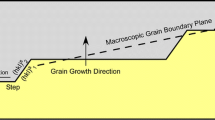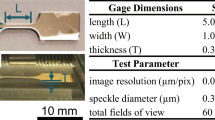Abstract
High-resolution transmission electron microscopy is often used to characterize grain boundaries, but it is usually limited to special high symmetry boundaries with a high density of coincident sites. For these ‘special’ boundaries, both crystals can be brought into a low-index zone-axis with the boundary plane parallel to the incident electron beam. In this case the atomistic structure of the boundary can be solved, which is not possible for other, more general grain boundaries. In the present study, general grain boundaries in SrTiO3 were analyzed using aberration-corrected transmission electron microscopy and scanning transmission electron microscopy. These boundaries included at least one type of disconnection (i.e., defects that can have a step and/or a dislocation component). Since the dislocation component of disconnections along general grain boundaries cannot be fully resolved using the methods currently available, a plane matching approach was used to compare disconnections at different boundaries. Using this approach, the dislocation component of the disconnections was partially characterized and was found to have an edge component mainly parallel to {100} and {110}, close to normal to the macroscopic grain boundary plane. The step component of the disconnections was found to be aligned mainly parallel to the same crystallographic planes ({100} and {110}).






Similar content being viewed by others
Reference
Gleiter H (1969) Mechanism of grain boundary migration. Acta Metall 17:565. https://doi.org/10.1016/0001-6160(69)90115-1
Gleiter H (1969) Theory of grain boundary migration rate. Acta Metall 17:853. https://doi.org/10.1016/0001-6160(69)90105-9
Pond RC, Hirth JP (1994) Defects at surfaces and interfaces. Sol State Phy 47:287–365. https://doi.org/10.1016/S0081-1947(08)60641-4
Khater HA, Serra A, Pond RC, Hirth JP (2012) The disconnection mechanism of coupled migration and shear at grain boundaries. Acta Mater 60:2007. https://doi.org/10.1016/j.actamat.2012.01.001
Hirth JP, Pond RC (1996) Steps, dislocations and disconnections as interface defects relating to structure and phase transformations. Acta Mater 44:4749. https://doi.org/10.1016/S1359-6454(96)00132-2
Pond RC, Ma X, Hirth JP, Mitchell TE (2007) Disconnections in simple and complex structures. Philos Mag 87:5289. https://doi.org/10.1080/14786430701651721
Howe JM, Pond RC, Hirth JP (2009) The role of disconnections in phase transformations. Prog Mater Sci 54:792. https://doi.org/10.1016/j.pmatsci.2009.04.001
Pond RC, Shang P, Cheng TT, Aindow M (2000) Interfacial dislocation mechanism for diffusional phase transformations exhibiting martensitic crystallography: formation of TiAl + Ti3Al lamellae. Acta Mater 48:1047. https://doi.org/10.1016/S1359-6454(99)00416-4
Pond R, Ma X, Chai Y, Hirth J (2007) Topological modelling of martensitic transformations. Dislocat Solids 13:225
Hirth JP (1994) Dislocations, steps and disconnections at interfaces. J Phys Chem Solids 55:985. https://doi.org/10.1016/0022-3697(94)90118-X
Han J, Thomas SL, Srolovitz DJ (2018) Grain-boundary kinetics: a unified approach. Prog Mater Sci 98:386. https://doi.org/10.1016/j.pmatsci.2018.05.004
Sternlicht H, Rheinheimer W, Hoffmann MJ, Kaplan WD (2016) The mechanism of grain boundary motion in SrTiO3. J Mater Sci 51:467. https://doi.org/10.1007/s10853-015-9058-1
Balluffi RW, Brokman A, King AH (1982) CSL/DSC lattice model for general crystalcrystal boundaries and their line defects. Acta Metall 30:1453. https://doi.org/10.1016/0001-6160(82)90166-3
Howe JM (1997) Interfaces in materials: atomic structure, kinetics and thermodynamics of solid–vapor, solid–liquid and solid–solid interfaces. Wiley, New York
Rheinheimer W, Hoffmann MJ (2015) Non-Arrhenius behavior of grain growth in strontium titanate: New evidence for a structural transition of grain boundaries. Scr Mater 101:68. https://doi.org/10.1016/j.scriptamat.2015.01.021
Rheinheimer W, Bäurer M, Handwerker CA, Blendell JE, Hoffmann MJ (2015) Growth of single crystalline seeds into polycrystalline strontium titanate: anisotropy of the mobility, intrinsic drag effects and kinetic shape of grain boundaries. Acta Mater 95:111. https://doi.org/10.1016/j.actamat.2015.05.019
Baurer M, Kungl H, Hoffmann MJ (2009) Influence of Sr/Ti Stoichiometry on the densification behavior of strontium titanate. J Am Ceram Soc 92:601. https://doi.org/10.1111/j.1551-2916.2008.02920.x
Barthel J, Houben L, and Tillmann K (2015) FEI Titan G3 50-300 PICO. J Large-Scale Res Facil, A34 1. https://doi.org/10.17815/jlsrf-1-57
Baram M, Kaplan WD (2008) Quantitative HRTEM analysis of FIB prepared specimens. J Microsc 232:395. https://doi.org/10.1111/j.1365-2818.2008.02134.x
http://qstem.org/ (2017)
Bishop CM, Cannon RM, Carter WC (2005) A diffuse interface model of interfaces: grain boundaries in silicon nitride. Acta Mater 53:4755. https://doi.org/10.1016/j.actamat.2005.07.008
Yu Z, Muller DA, Silcox J (2004) Study of strain fields at a-Si/c-Si interface. J Appl Phys 95:3362. https://doi.org/10.1063/1.1649463
Huang K (1947) X-Ray reflexions from dilute solid solutions. Proc R Soc Ser A Math Phys Sci 190:102. https://doi.org/10.1098/rspa.1947.0064
Wang ZL (1995) Elastic and inelastic scattering in electron diffraction and imaging. Plenum Press, New York
Klie RF, Browning ND (2000) Atomic scale characterization of oxygen vacancy segregation at SrTiO3 grain boundaries. Appl Phys Lett 77:3737. https://doi.org/10.1063/1.1330572
Browning ND, Pennycook SJ, Chisholm MF, McGibbon MM, McGibbon AJ (1995) Observation of structural units at symmetric [001] tilt boundaries in SrTiO3. Interface Sci 2:397. https://doi.org/10.1007/BF00222626
Browning ND, Buban JP, Moltaji HO, Pennycook SJ, Duscher G, Johnson KD, Rodrigues RP, Dravid VP (1999) The influence of atomic structure on the formation of electrical barriers at grain boundaries in SrTiO3. Appl Phys Lett 74:2638. https://doi.org/10.1063/1.123922
Kim M, Duscher G, Browning ND, Sohlberg K, Pantelides ST, Pennycook SJ (2001) Nonstoichiometry and the electrical activity of grain boundaries in SrTiO3. Phys Rev Lett 86:4056
Sternlicht H, Rheinheimer W, Kim J, Liberti E, Kirkland AI, Hoffmann MJ, and Kaplan WD, Characterization of grain boundary disconnections in SrTiO3 part II: The influence of superimposed disconnections in image analysis. J Mater Sci. https://doi.org/10.1007/s10853-018-3095-5
Du H, Jia C-L, Houben L, Metlenko V, De Souza RA, Waser R, Mayer J (2015) Atomic structure and chemistry of dislocation cores at low-angle tilt grain boundary in SrTiO3 bicrystals. Acta Mater 89:344. https://doi.org/10.1016/j.actamat.2015.02.016
Nishigaki J, Kuroda K, Saka H (1991) Electron microscopy of dislocation structures in SrTiO3 deformed at high temperatures. Phys Status Solidi (a) 128:319. https://doi.org/10.1002/pssa.2211280207
Matsunaga T, Saka H (2000) Transmission electron microscopy of dislocations in SrTiO3. Philos Mag Lett 80:597. https://doi.org/10.1080/09500830050134309
Narayan J, Sharan S, Singh RK, Jagannadham K (1989) Misfit dislocations in superconducting thin films on SrTiO3{010}. Mater Sci Eng B 2:333. https://doi.org/10.1016/0921-5107(89)90009-3
Jia C-L, Lentzen M, Urban K (2004) High-resolution transmission electron microscopy using negative spherical aberration. Microsc Microanal 10:174. https://doi.org/10.1017/S1431927604040425
Sutton AP, Balluffi RW (1995) Interfaces in crystalline materials. Clarendon Press, Oxford
Howe JM, Aaronson HI, Hirth JP (2000) Aspects of interphase boundary structure in diffusional phase transformations. Acta Mater 48:3977. https://doi.org/10.1016/S1359-6454(00)00183-X
Rheinheimer W, Bäurer M, Chien H, Rohrer GS, Handwerker CA, Blendell JE, Hoffmann MJ (2015) The equilibrium crystal shape of strontium titanate and its relationship to the grain boundary plane distribution. Acta Mater 82:32. https://doi.org/10.1016/j.actamat.2014.08.065
Saylor DM, El Dasher B, Sano T, Rohrer GS (2004) Distribution of grain boundaries in SrTiO3 as a function of five macroscopic parameters. J Am Ceram Soc 87:670. https://doi.org/10.1111/j.1551-2916.2004.00670.x
Sano T, Saylor DM, Rohrer GS (2003) Surface energy anisotropy of SrTiO3 at 1400 °C in air. J Am Ceram Soc 86(11):1933–1939
Furushima Y, Arakawa Y, Nakamura A, Tochigi E, Matsunaga K (2017) Nonstoichiometric [012] dislocation in strontium titanate. Acta Mater 135:103. https://doi.org/10.1016/j.actamat.2017.06.017
Acknowledgements
The authors acknowledge Lothar Houben for assistance with acquiring the data set presented in Figs. 1 and 2 in this manuscript and Fig. S1 and S2 in the supplementary material, and for detailed discussions. The authors thank D. Medlin for his comments on the manuscript and extended discussions. This work was partially supported via a German-Israel Fund (GIF) Grant No. I-1276-401.10/2014.
Author information
Authors and Affiliations
Corresponding author
Additional information
Hadas Sternlicht: Conducted when the author was at Department of Materials Science and Engineering, Technion—Israel Institute of Technology, Haifa Israel.
Wolfgang Rheinheimer: Conducted when the author was at Institute of Applied Materials, Karlsruhe Institute of Technology, Karlsruhe, Germany.
Electronic supplementary material
Below is the link to the electronic supplementary material.
Rights and permissions
About this article
Cite this article
Sternlicht, H., Rheinheimer, W., Dunin-Borkowski, R.E. et al. Characterization of grain boundary disconnections in SrTiO3 part I: the dislocation component of grain boundary disconnections. J Mater Sci 54, 3694–3709 (2019). https://doi.org/10.1007/s10853-018-3096-4
Received:
Accepted:
Published:
Issue Date:
DOI: https://doi.org/10.1007/s10853-018-3096-4




